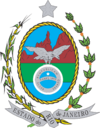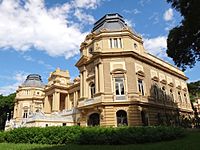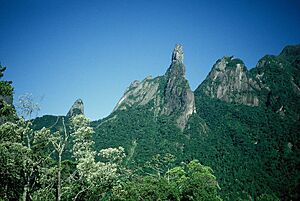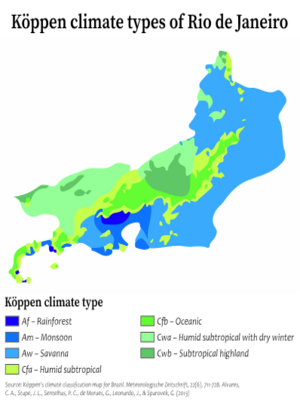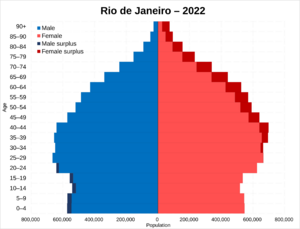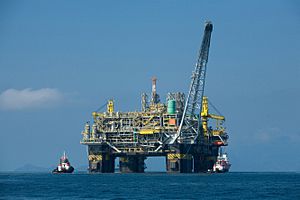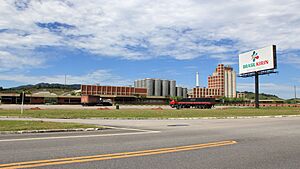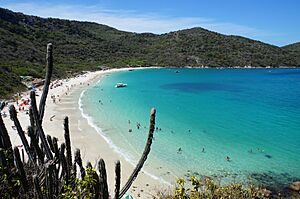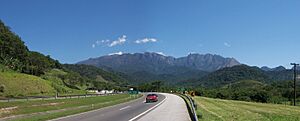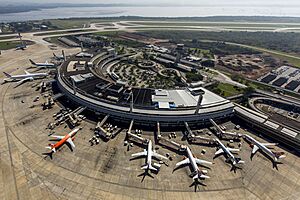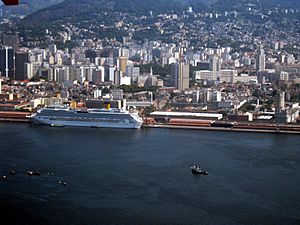Rio de Janeiro (state) facts for kids
Quick facts for kids
Rio de Janeiro
|
|||
|---|---|---|---|
|
|||
| Nickname(s):
Beautiful state
|
|||
| Motto(s):
Recte Rem Publicam Gerere (Latin)
"Conduct the affairs of the public with righteousness" |
|||
| Anthem: Hino 15 de Novembro | |||
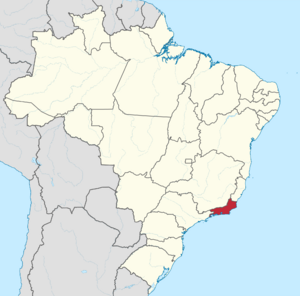 |
|||
| Country | |||
| Founded | December 8, 1897 | ||
| Capital | Rio de Janeiro | ||
| Government | |||
| • Body | Legislative Assembly | ||
| Area | |||
| • Total | 43,696.1 km2 (16,871.2 sq mi) | ||
| Area rank | 24th | ||
| Population
(2022 Census)
|
|||
| • Total | 16,055,174 | ||
| • Estimate
(July 1, 2024)
|
17,219,679 | ||
| • Rank | 3rd | ||
| • Density | 367.4281/km2 (951.6344/sq mi) | ||
| • Density rank | 2nd | ||
| Demonym(s) | Fluminense, carioca, papa-goiaba | ||
| GDP (nominal) | |||
| • Year | 2021 | ||
| • Total | R$ 949.301 billion (US$ 176.095 billion) (2nd) |
||
| • Per capita | R$ 59,127 US$ 10,968 (3rd) |
||
| HDI | |||
| • Year | 2021 | ||
| • Category | 0.769 – high (8th) | ||
| Time zone | UTC-3 (BRT) | ||
| Postal Code |
20000-000 to 28990-000
|
||
| ISO 3166 code | BR-RJ | ||
| License Plate Letter Sequence | KMF to LVE, RIO, RIP to RKV, SQV to SSE | ||
Rio de Janeiro is one of the 27 states that make up Brazil. It has the second largest economy in Brazil, right after the state of São Paulo. Even though it has 8.2% of Brazil's population, it creates 9.2% of the country's total GDP.
The state of Rio de Janeiro is in the Southeast part of Brazil. It shares borders with Minas Gerais (to the North and Northwest), Espírito Santo (to the Northeast), and São Paulo (to the Southwest). To its east and south is the South Atlantic Ocean. Rio de Janeiro covers an area of about 43,653 square kilometers. Its capital city is Rio de Janeiro. This city was once the capital of Portuguese Brazil (from 1763 to 1815) and later of independent Brazil (from 1822 to 1960).
Rio de Janeiro is the smallest state in the Southeast region by area. However, it is the third most populated state in Brazil. Over 16 million people lived here in 2022, making it the most densely populated state. It also has the third longest coastline in Brazil.
In the Brazilian flag, the state is shown by the star Mimosa. This star is the beta star in the Southern Cross constellation.
The 22 largest cities in the state include:
- Rio de Janeiro
- São Gonçalo
- Duque de Caxias
- Nova Iguaçu
- Niterói
- Campos dos Goytacazes
- Belford Roxo
- São João de Meriti
- Petrópolis
- Volta Redonda
- Magé
- Macaé
- Itaboraí
- Cabo Frio
- Armação dos Búzios
- Angra dos Reis
- Nova Friburgo
- Barra Mansa
- Barra do Piraí
- Teresópolis
- Mesquita
- Nilópolis
Contents
- What are the names for people from Rio de Janeiro?
- A Look at Rio de Janeiro's Past
- Rio de Janeiro's Geography
- Who lives in Rio de Janeiro?
- What drives Rio de Janeiro's economy?
- Exploring Tourism in Rio de Janeiro
- How is Rio de Janeiro's Infrastructure?
- Sports in Rio de Janeiro
- What does the State Flag of Rio de Janeiro mean?
- Images for kids
- See also
What are the names for people from Rio de Janeiro?
The official name for someone from the State of Rio de Janeiro is fluminense. This word comes from the Latin word flumen, which means "river". The word carioca is an older term, first used in 1502.
For a long time, fluminense was the official term for people from the state. Carioca was an informal name for people living in the city of Rio de Janeiro. When the city of Rio de Janeiro became the State of Guanabara in 1960, carioca became an official name for its residents. In 1975, Guanabara State joined with Rio de Janeiro State. Now, carioca is used for people from the city of Rio de Janeiro, while fluminense is for people from the state as a whole.
A Look at Rio de Janeiro's Past
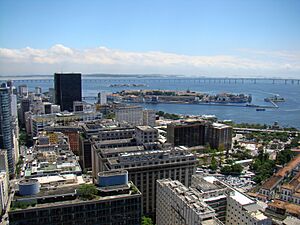
European people first arrived in the Rio de Janeiro area in 1502. The state of Rio de Janeiro was formed from parts of older areas called captainships. Between 1555 and 1567, the French tried to set up a colony here called France Antarctique. To stop them, Estácio de Sá founded the city of Rio de Janeiro in March 1565.
In the 1600s, raising cattle and growing sugar cane helped the city grow. Its importance really increased in the 1700s when its port started exporting gold from Minas Gerais. In 1763, Rio de Janeiro became the capital of Colonial Brazil.
When the Portuguese royal family moved from Portugal to Brazil in 1808, the region changed a lot. New public offices, churches, and hospitals were built. The first bank in Brazil, the Bank of Brazil, was founded. The Botanical Garden was also created. European artists came to record Brazilian society and nature, adding to the cultural growth.
How Rio Became a "Neutral City"
In 1834, the city of Rio de Janeiro was made a "neutral city." This meant it stayed the capital of Brazil, while the surrounding area became a province with its own capital in Niterói. In 1889, Brazil became a republic. The neutral city became the federal district, and the province became a state. Petrópolis was the capital of Rio de Janeiro state from 1894 until 1902, when Niterói became the capital again.
In 1960, the capital of Brazil moved to Brasília. The city of Rio de Janeiro then became its own state, called Guanabara State. Niterói remained the capital for Rio de Janeiro state.
The Modern State of Rio de Janeiro
In 1975, another big change happened. The states of Rio de Janeiro and Guanabara merged into one state. The city of Rio de Janeiro became a regular municipality again, led by mayors.
In the 1970s, after the capital moved to Brasília, Rio de Janeiro faced economic challenges. The state is still Brazil's largest oil producer, providing about 80% of the country's total oil. This brings in a lot of money for the state.
Rio de Janeiro's Geography
The state of Rio de Janeiro is part of the Mata Atlântica (Atlantic Forest) biome. It has two main types of land: a flat coastal plain and a higher plateau. These run side-by-side from the Atlantic Ocean inland towards Minas Gerais.
The coastline is 635 kilometers long. It includes famous bays like Guanabara, Sepetiba, and Ilha Grande. Near the ocean, you can find steep slopes, sandy restinga vegetation, calm bays, beautiful lagoons, and thick tropical forests.
Most of the state is made up of highlands, often over 1000 meters tall. These are formed by mountain ranges like the Serra do Mar. The highest point in the state is the Pico das Agulhas Negras (Black Needles Peak). It is located in the Serra da Mantiqueira mountains, which form the border with Minas Gerais.
The main rivers in the state are the Guandu, Piraí, Paraíba do Sul, Macaé, and Muriaé.
What is the climate like in Rio de Janeiro?
The entire state is in the tropics, so it mostly has a tropical climate. However, in higher areas, temperatures can drop a lot. Frost can happen in mountain cities like Teresópolis, Nova Friburgo, and Petrópolis. Snow has even been seen sometimes in the Itatiaia National Park.
Along the coast, the average yearly temperature is around 23°C (73°F). Summers average 26°C (79°F), and winters average 20°C (68°F). In the mountains, the average yearly temperature is about 18°C (64°F). This can range from 20°C (68°F) at lower mountain elevations to 7°C (45°F) in Itatiaia National Park. Summers in these areas are warm but not too hot, around 22°C (72°F). Winters are quite cool for Brazil, with lows around 8-9°C (46-48°F).
Most rain falls in the summer (December to March). There is a dry season in the winter (June to September). The state usually gets between 1000 and 1500 mm (39-59 inches) of rain each year.
Who lives in Rio de Janeiro?
According to the 2022 census, 16,055,174 people live in Rio de Janeiro state. The population density is about 367 people per square kilometer. Most people live in cities, with 96.9% living in urban areas in 2004.
The census also showed the following groups:
- 42.0% White people
- 41.6% Pardo (Multiracial) people
- 16.2% Black people
- 0.1% Asian people
- 0.1% Amerindian people
Many people in the state have Portuguese ancestors. In 1920, almost 40% of all Portuguese people living in Brazil were in Rio de Janeiro. Other European ethnic groups, like Swiss, Finnish, and Germans, settled in the mountain areas. Italians and Spaniards also live in the capital and nearby cities.
Largest Cities by Population
|
Largest cities or towns in Rio de Janeiro
(2011 census by the Brazilian Institute of Geography and Statistics) |
||
|---|---|---|
| Rank | Pop. | |
| 1 | Rio de Janeiro | 6 355 949 |
| 2 | São Gonçalo | 1 008 064 |
| 3 | Duque de Caxias | 861 157 |
| 4 | Nova Iguaçu | 799 047 |
| 5 | Niterói | 489 720 |
| 6 | Belford Roxo | 472 008 |
| 7 | Campos dos Goytacazes | 468 086 |
| 8 | São João de Meriti | 459 379 |
| 9 | Petrópolis | 296 565 |
| 10 | Volta Redonda | 259 011 |
Racial groups of Rio de Janeiro in 2022 White (41.98%) Multiracial (41.62%) African (16.17%) East Asian (0.13%) Indigenous (0.10%)
What religions are practiced in Rio de Janeiro?
Religion in Rio de Janeiro (2010) Catholicism (45.8%) Protestantism (29.4%) Spiritism (4.0%) Other (6.2%) No religion (14.6%)
Based on the 2010 Brazilian census, here's a look at religions in Rio de Janeiro:
- 45.8% are Roman Catholics.
- 29.4% are Protestants.
- 4% are Spiritists.
- 14.6% reported having no religion (like atheists or agnostics).
- Other religions, including Islam, Judaism, Buddhism, and Afro-Brazilian religions, make up 6.2%.
Rio de Janeiro has the lowest percentage of Catholics in Brazil. It also has the highest percentage of people with no religion. The state shows a wide variety of religious beliefs.
How is education in Rio de Janeiro?
Rio de Janeiro state has the 4th best education system in Brazil. It is behind only the Federal District, São Paulo, and Goiás. The state also has one of the lowest rates of people who cannot read or write, with only about 4% of its population. This rate is similar to countries like Singapore and China.
Colleges and Universities in Rio
Many of the best universities in the state are public. The Federal University of Rio de Janeiro (UFRJ) is considered one of the best federal universities in Brazil. It is also ranked among the top universities in Latin America.

Here are some other well-known colleges and universities in the state:
Public Universities
- Federal University of Rio de Janeiro (UFRJ)
- State University of Rio de Janeiro (UERJ)
- Fluminense Federal University (UFF)
- Federal University of the State of Rio de Janeiro (UNIRIO)
- Federal Rural University of Rio de Janeiro (UFRRJ)
- Military Institute of Engineering (IME-RJ)
- State University of Northern Rio de Janeiro (UENF)
- Federal Institute of Rio de Janeiro (IFRJ)
- Fluminense Federal Institute (IFF)
- Centro Universitário Estadual da Zona Oeste (UEZO)
Private Universities
- Pontifical Catholic University of Rio de Janeiro (PUC-RIO)
- Catholic University of Petrópolis (UCP)
- Estácio De Sá University (UNESA)
- Fundação Getúlio Vargas (FGV)
- Universidade Grande Rio (UNIGRANRIO)
- Universidade Cândido Mendes (UCAM)
- University of Vassouras (USS)
- Universidade Castelo Branco (UCB)
- Universidade Santa Úrsula (USU)
- Universidade Veiga de Almeida (UVA)
- Universidade Salgado de Oliveira (UNIVERSO)
What drives Rio de Janeiro's economy?
The economy of Rio de Janeiro state mostly relies on services. Industry also plays a big part, but agriculture has a small role, making up only 0.4% of the state's total economic output.
In the past, growing sugar cane and coffee were very important. The area around Campos dos Goytacazes was a huge sugar cane producer. Today, the state is known for some other farm products. It is the 4th largest producer of pineapple in Brazil. It also produces cassava, banana, orange, tangerine, lemon, and persimmon.
The industrial sector makes up the largest part of the state's economy at 51.6%. The service sector is close behind at 47.8%. Rio de Janeiro state exports a lot of petroleum (44.8%), fuel (17.5%), and siderurgy (13%). It also exports chemicals, nonferrous metals, and vehicles.
The state has many vehicles (over 3.9 million in 2006) and mobile phones (10 million). It has 92 cities.
Exploring Tourism in Rio de Janeiro
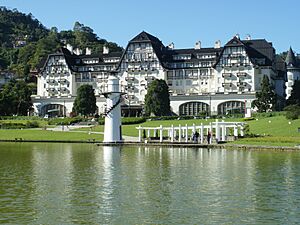
Rio de Janeiro city welcomes more foreign tourists than any other city in Latin America. It receives almost 40% of all foreign tourists who visit Brazil. It is also the most visited city in Brazil overall. A global travel guide called it one of the ten most beautiful cities in the world.
The capital city is famous for its beautiful beaches and mountains. Key places to visit include:
- Christ the Redeemer statue, one of the seven wonders of the modern world.
- Sugarloaf Mountain with its famous cable car.
- Rodrigo de Freitas Lagoon.
- Beaches like Copacabana, Ipanema, and Barra da Tijuca.
- Tijuca forest.
- Rio de Janeiro Botanical Garden.
- Maracanã stadium.
Two of the biggest events in Rio are the Carnival and the New Year's party on Copacabana Beach. The Carnival is the biggest party on Earth, with millions of people celebrating in the streets. The New Year's party is also huge, with millions gathering on the city's beaches.
Four of the top 10 most visited cities for leisure in Brazil are in Rio de Janeiro state. Besides the capital, popular spots include:
- Armação dos Búzios and Angra dos Reis in the Lakes Region, known for high-end tourism.
- The historic town of Paraty with its colonial buildings.
- The beaches of Cabo Frio and Arraial do Cabo.
- Ilha Grande.
The mountainous region offers cool escapes. These include the imperial city of Petrópolis, Teresópolis, Nova Friburgo, and the villages of Penedo and Visconde de Mauá.
How is Rio de Janeiro's Infrastructure?
Roads and Highways
Rio de Janeiro state has good infrastructure, especially its roads. It has about 800 km (500 miles) of highways. The main highways are BR-101 and BR-116. The Presidente Dutra highway (part of BR-116) connects Rio to São Paulo. It was the first divided highway in Brazil, built in 1967.
BR-101 connects the capital to the border with Espírito Santo, passing through cities like Niterói and Campos dos Goytacazes. BR-116 goes through the state's mountainous interior and links Rio de Janeiro to northeastern Brazil. The BR-040 connects Rio to Minas Gerais and its capital, Belo Horizonte. The Metropolitan Arc is a highway that goes around the capital to reduce traffic.
The main Federal highways in the state are:
- BR-101
- BR-116
- BR-040
- BR-354
- BR-356
- BR-393
- BR-465
- BR-493
- BR-495
International Airport
Since 2004, Rio de Janeiro-Galeão International Airport has been Brazil's second international airport. Many foreign tourists choose Rio as their entry point to Brazil. Galeão connects Rio to the rest of Brazil and 18 other countries. It can handle up to 15 million passengers each year.
The airport is about 20 kilometers (12 miles) from downtown Rio. It is easy to reach using major roads like Linha Vermelha and Avenida Brasil. There are also shuttle buses to Santos Dumont Airport and other parts of the city. Galeão has Brazil's longest runway (4,240 meters or 13,910 feet) and a large cargo terminal.
Ports
Rio de Janeiro has several important ports. These include the Port of Rio de Janeiro, the Port of Itaguaí, and the Port of Açu. Other ports are in Niterói and Angra dos Reis. All ports have good rail and road connections.
The Port of Rio de Janeiro exports iron and steel from Minas Gerais. It imports containers, wheat, and other goods. The Port of Itaguaí exports iron ore and imports coal. The Port of Açu is a major private terminal for iron ore and oil exports. It is also building a large power plant and has the world's biggest offshore support base.
Sports in Rio de Janeiro
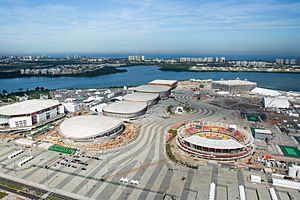
The most popular sport in Rio de Janeiro state is football. The four main football clubs are Clube de Regatas do Flamengo, Botafogo, Fluminense, and Vasco da Gama. The state is also known for great athletes in volleyball, yachting, swimming, basketball, skateboarding, surfing, beach volleyball, rowing, jiu-jitsu, and MMA.
Rio de Janeiro has hosted major international sports events:
- The finals of the 1950 and 2014 FIFA World Cup.
- The 2016 Summer Olympics.
- The 2007 Pan American Games.
- World championships in swimming and basketball.
Horse racing happens at the Gávea Hippodrome. The Jacarepaguá track hosted the Formula One Grand Prix from 1978 to 1990. The capital also hosts an ATP 500 tennis tournament.
The capital city has three major stadiums:
- Maracanã, once the largest stadium in the world.
- Engenhão, built for the 2007 Pan American Games.
- São Januário, the largest private stadium in Rio.
Many Olympic medalists were born in Rio state, including:
- Sailors like Martine Grael and Marcelo Ferreira.
- Swimmers like Thiago Pereira and Bruno Fratus.
- Volleyball players like André Nascimento and Thaísa.
- Skateboarder Bob Burnquist, considered one of the greatest ever.
- Formula One world champion Nelson Piquet.
What does the State Flag of Rio de Janeiro mean?
The state flag features an eagle, which is a symbol of Brazil's royal family. In the background, you can see the Dedo de Deus (The Finger of God) rock formation. This famous peak is near Teresópolis.
The outer parts of the flag's coat of arms show the state's rich agriculture. On the left is sugarcane, and on the right is coffee.
- Flags used in Rio de Janeiro over the years
Images for kids
-
Niterói, one of the most famous and developed cities of the state
-
Quitandinha Palace in Petrópolis, The Imperial City
-
A farm scene in the countryside of the state
See also
 In Spanish: Estado de Río de Janeiro para niños
In Spanish: Estado de Río de Janeiro para niños



